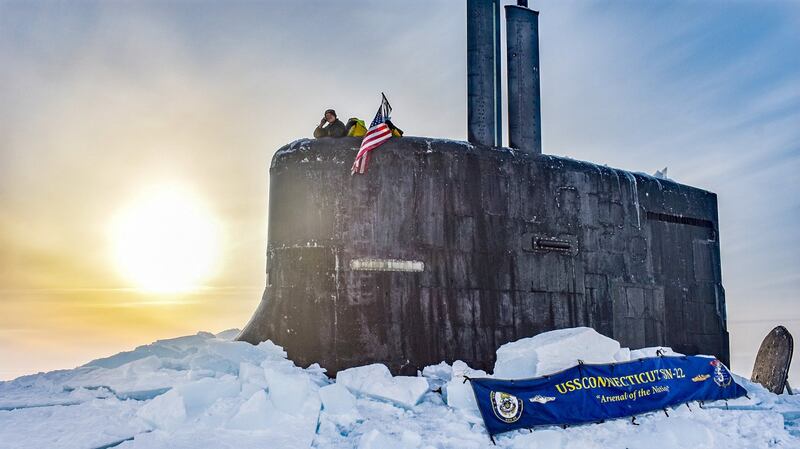The United States is denying China’s accusation that it has been covering up a submarine collision that occurred earlier this month in the South China Sea.
On Monday, Chinese Foreign Ministry spokesman Zhao Lijian called the delay in releasing information about the incident an "irresponsible attitude and stonewalling and cover-up practice."
When asked about the Chinese spokesman's statement on Tuesday, U.S Department of Defense press secretary John Kirby said: "It's an odd way of covering something up when you put out a press release about it."
Kirby did not provide any additional detail of the incident on Oct. 2, saying itis a Navy matter.
Five days after the event, on Oct. 7 the U.S. Pacific Fleet issued a statement saying the Seawolf-class fast-attack submarine USS Connecticut (SSN 22) struck an unknown object while operating in “international waters in the Indo-Pacific region,” but there were no life-threatening injuries to the sailors.
It added that the sub’s “nuclear propulsion plant and spaces were not affected and remain fully operational.”
The submarine arrived at Naval Base Guam on Friday where it would undergo an assessment and preliminary repairs while the Navy investigates the collision, according to Associated Press news agency.
Meanwhile, the South China Sea Probing Initiative, a Beijing-based think tank, said that based on satellite imagery, the USS Connecticut was spotted in waters off the Paracel islands on Oct. 3, one day after the reported collision.
It suggested that the U.S. submarine could have been “assigned to guard the (aircraft carrier) USS Carl Vinson or to spy on PLA's SSBNs” - Chinese army ballistic missile submarines.
While not commenting about the Chinese think tank’s suggestion, Rear Adm. James Goldrick, fellow at the naval research institute Sea Power Centre - Australia, said submarines have the right under the UN Law of the Sea to operate submerged anywhere in the seas outside the 12 nautical mile territorial limit of coastal states.

China ramps up criticism
China has been vocal with its criticism of the delayed U.S. announcement of the incident, saying it only makes “the international community more suspicious of the U.S. intention.”
Beijing’s spokesman said the U.S. “should take a responsible attitude, give a detailed account of what happened as soon as possible and make a satisfactory explanation” of the incident’s location and whether it caused a nuclear leakage as well as marine pollution.
Alexander Neill, a defense and security consultant based in Singapore, said: “China is playing up the risks because of the AUKUS (Australia-U.K.-U.S. trilateral security pact) announcement.”
The tripartite defense partnership announced last month will help Australia develop nuclear submarines. It is widely viewed as a pushback against growing Chinese military power in the region. China has been calling the pact “extremely irresponsible,” and saying that AUKUS “seriously undermines regional peace and intensifies the arms race.”
“In the light of AUKUS and China’s anti-AUKUS narrative, this is a windfall for Beijing, perfect for the narrative that the U.S. and allies are nuclearizing the South China Sea and violating counter proliferation regimes,” Neill said.
But he said there was no nuclear leak or damage to the nuclear propulsion system of the USS Connecticut although there’s still little known about the cause of the collision.
Anonymous U.S. defense sources were quoted in media reports as saying at the weekend that 11 sailors were hurt in the incident.
Risky business
“Sub patrols are risky and sometimes dangerous, especially when subs are at periscope depth,” explained Neill, pointing out that “there is always the risk of hitting junk in the sea like wrecks or lost containers, or fishing vessels and even sea animals.”
In 2003, after surfacing in an ice pack between the North Pole and Alaska, the same USS Connecticut was stalked by a polar bear for 30 minutes. Luckily the bear only chewed briefly on the rudder and didn’t cause any damage to the submarine.
But some other submarine incidents proved fatal. The USS San Francisco struck a seamount near Guam at full speed in 2005, killing one sailor and injuring 24 others; and in 2001 the USS Greeneville collided with a Japanese ship in waters near Hawaii, killing nine Japanese fishermen.
“An Indonesian sub sank a few months ago and Singapore offered to send a rescue sub. If China or the U.S. had a similar accident would they help each other?” Neill asked.
“What if the U.S. sub hit a Chinese vessel and people died? That would be the recipe for fast escalation with China!”
According to the Singapore-based security expert, “this demonstrates that there is always a potential for unmanaged escalation in the submarine domain.”
“There should be protocols for unplanned encounters and incidents at sea.”
“It is up to a submarine itself to ensure it doesn’t hit anything,” Goldrick said, adding: “But, if there is an uncharted obstruction at the depth at which it is operating, then it may be practically impossible for a submarine running silently with no active sonar to detect it.”
Observers say the South China Sea has become a flashpoint of tensions between the U.S. and China and a potential conflict zone between the two powers.
China itself is very selective about publicizing its maritime activities in the South China Sea. Its excessive claims in those waters are not recognised by international law and rejected by neighboring states.
In 2009, a Chinese submarine collided with a sonar array being towed by the U.S. Navy destroyer USS John S. McCain near Subic Bay in the Philippines, causing damage to the sonar but no further details were provided.
China has the largest navy in the world including a dozen nuclear-powered submarines. This number is likely to increase to 21 by 2030, according to the U.S.’s Office of Naval Intelligence.
